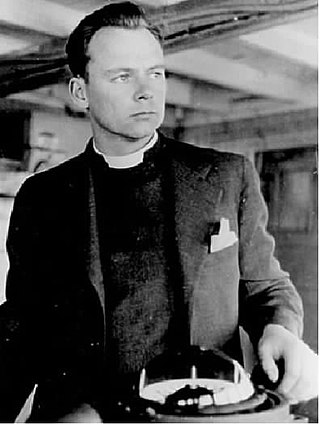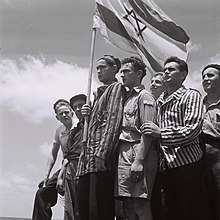
Aliyah is the immigration of Jews from the diaspora to, historically, the geographical Land of Israel or the Palestine region, which is today chiefly represented by the State of Israel. Traditionally described as "the act of going up", moving to the Land of Israel or "making aliyah" is one of the most basic tenets of Zionism. The opposite action – emigration by Jews from the Land of Israel – is referred to in the Hebrew language as yerida. The Law of Return that was passed by the Israeli parliament in 1950 gives all diaspora Jews, as well as their children and grandchildren, the right to relocate to Israel and acquire Israeli citizenship on the basis of connecting to their Jewish identity.

The Jewish Infantry Brigade Group, more commonly known as the Jewish Brigade Group or Jewish Brigade, was a military formation of the British Army in the Second World War. It was formed in late 1944 and was recruited among Yishuv Jews from Mandatory Palestine and commanded by Anglo-Jewish officers. It served in the latter stages of the Italian Campaign, and was disbanded in 1946.
Darien II was the last ship to bring Aliya Bet refugees to Haifa during World War II. A former lighthouse tender, she sailed from the Black Sea to Palestine in early 1941.
Aliyah Bet was the code name given to illegal immigration by Jews, many of whom were refugees escaping from Nazi Germany or other Nazi-controlled countries, and later Holocaust survivors, to Mandatory Palestine between 1920 and 1948, in violation of the restrictions laid out in the British White Paper of 1939, which dramatically increased between 1939 and 1948. With the establishment of the State of Israel in May 1948, Jewish displaced persons and refugees from Europe began streaming into the new state in the midst of the 1948 Palestine war.

The Atlit detainee camp was a concentration camp established by the authorities of Mandatory Palestine in the late 1930s on what is now the Israeli coastal plain, 20 kilometres (12 mi) south of Haifa. Under British rule, it was primarily used to hold Jews and Arabs who were in administrative detention; it largely held Jewish immigrants who did not possess official entry permits. Tens of thousands of Jewish refugees were interned at the camp, which was surrounded by barbed wire and watchtowers.

The Kielce pogrom was an outbreak of violence toward the Jewish community centre's gathering of refugees in the city of Kielce, Poland, on 4 July 1946 by Polish soldiers, police officers, and civilians during which 42 Jews were killed and more than 40 were wounded. Polish courts later sentenced nine of the attackers to death in connection with the crimes.
Following the establishment of the Second Polish Republic after World War I and during the interwar period, the number of Jews in the country grew rapidly. According to the Polish national census of 1921, there were 2,845,364 Jews living in the Second Polish Republic; by late 1938 that number had grown by over 16 percent, to approximately 3,310,000, mainly through migration from Ukraine and the Soviet Russia. The average rate of permanent settlement was about 30,000 per annum. At the same time, every year around 100,000 Jews were passing through Poland in unofficial emigration overseas. Between the end of the Polish–Soviet War of 1919 and late 1938, the Jewish population of the Republic grew by nearly half a million, or over 464,000 persons. Jews preferred to live in the relatively-tolerant Poland rather than in the Soviet Union and continued to integrate, marry into Polish Gentile families, to bring them into their community through marriage, feel Polish and form an important part of Polish society. Between 1933 and 1938, around 25,000 German Jews fled Nazi Germany to sanctuary in Poland.

The Patria disaster was the sinking on 25 November 1940 by the Jewish paramilitary organization Haganah of a French-built ocean liner, the 11,885-ton SS Patria, in the port of Haifa.

Exodus 1947 was a packet steamship that was built in the United States in 1928 as President Warfield for the Baltimore Steam Packet Company. From her completion in 1928 until 1942 she carried passengers and freight across Chesapeake Bay between Norfolk, Virginia and Baltimore, Maryland.
Sh'erit ha-Pletah is a Hebrew term for Ashkenazi Holocaust survivors living in Displaced Persons (DP) camps, and the organisations they created to act on their behalf with the Allied authorities. These were active between 27 May 1945 and 1950–51, when the last DP camps closed.

The Selvino children were a group of approximately 810 Jewish children orphaned by the Holocaust, rescued after World War II from ghettos and concentration camps and housed in a former Fascist children's home called Sciesopoli in the Alpine town of Selvino, Italy. The facility had been constructed in the 1930s as a "sports palace" or gymnasium and training centre for athletes. There, the children were allowed to recover physically, mentally, and spiritually from their ordeal, while being instructed both in the general education they had missed during their imprisonment, as well as in their heritage of Judaism and Judaic culture, in preparation for their later relocation to the still British-ruled Mandatory Palestine as part of the Bricha immigration programme. The house was run by members of a Palestinian Jewish unit of the British Army stationed in Northern Italy under Moshe Zeiri, along with the generous help of many Italian citizens. From early 1947 to May 1948, when the State of Israel was declared, Amalia (Mania) Schoeps was director of Sciesopoli.

The Holocaust in Poland was the ghettoization, robbery, deportation and mass murder of Jews, alongside other groups under similar racial pretexts in occupied Poland by the Nazi Germany. 3,000,000+ Polish Jews were murdered, primarily at the Chelmno, Belzec, Sobibor, Treblinka and Auschwitz extermination camps, who made up half of the Jewish Holocaust victims.
The Mossad LeAliyah Bet was a branch of the paramilitary organization Haganah in British Mandatory Palestine, and later the State of Israel, that operated to facilitate Jewish immigration to British Palestine. During the Mandate period, it was facilitating illegal immigration in violation of governmental British restrictions. It operated from 1938 until four years after the founding of the State of Israel in 1952. It was funded directly by the American Jewish Joint Distribution Committee, and was not subject to the control of the Jewish Agency who operated their own Aliyah department headed by Yitzhak Rafael.
Holocaust survivors are people who survived the Holocaust, defined as the persecution and attempted annihilation of the Jews by Nazi Germany and its allies before and during World War II in Europe and North Africa. There is no universally accepted definition of the term, and it has been applied variously to Jews who survived the war in German-occupied Europe or other Axis territories, as well as to those who fled to Allied and neutral countries before or during the war. In some cases, non-Jews who also experienced collective persecution under the Nazi regime are considered Holocaust survivors as well. The definition has evolved over time.

Nakam was a paramilitary organisation of about fifty Holocaust survivors who, after 1945, sought revenge for the murder of six million Jews during the Holocaust. Led by Abba Kovner, the group sought to kill six million Germans in a form of indiscriminate revenge, "a nation for a nation". Kovner went to Mandatory Palestine in order to secure large quantities of poison for poisoning water mains to kill large numbers of Germans. His followers infiltrated the water system of Nuremberg. However, Kovner was arrested upon arrival in the British zone of occupied Germany and had to throw the poison overboard.
Anti-Jewish violence in Poland from 1944 to 1946 preceded and followed the end of World War II in Europe and influenced the postwar history of the Jews and Polish-Jewish relations. It occurred amid a period of violence and anarchy across the country caused by lawlessness and anti-communist resistance against the Soviet-backed communist takeover of Poland. The estimated number of Jewish victims varies, ranging up to 2,000. In 2021, Julian Kwiek published the first scientific register of incidents and victims of anti-Jewish violence in Poland from 1944 to 1947; according to Kwiek's calculations, the number of victims was 1,074 to 1,121. Jews constituted between two and three percent of the total number of victims of postwar violence in the country, including Polish Jews who managed to escape the Holocaust in territories of Poland annexed by the Soviet Union, and returned after the border changes imposed by the Allies at the Yalta Conference. Incidents ranged from individual attacks to pogroms.

Tilhas Teezee Gesheften was a group of Jewish Brigade members formed immediately following World War II. Under the guise of British military activity, this group engaged in the assassination of Nazis and SS conspirators, facilitated the illegal emigration of Holocaust survivors to Mandatory Palestine, and smuggled weaponry for the Haganah.
Samuel Brand was a German Jew who became officially the first immigrant to enter the State of Israel after its creation on 14 May 1948. He was also a survivor of the Buchenwald concentration camp in Nazi Germany. Brand carried with him the first visa ever issued by the Government of Israel.

John Stanley Grauel was a Methodist minister and American Christian Zionist leader. He was a crew member of the Aliyah Bet ship Exodus1947 and a secret Haganah operative. Grauel is sometimes credited with being the key individual who persuaded the United Nations Special Committee on Palestine to recommend for the Partition Resolution of November 1947, creating the State of Israel. In a speech to the Jewish Agency, Golda Meir, referred to his testimony as the first appeal by a “priest, a perfectly worthy gentile, a priori, no Jewish witness was to be believed.”

Samuel Herschel Schulman was the last surviving American crew member of the ship Exodus1947, which tried to bring thousands of Holocaust survivors from Europe to Mandatory Palestine. Born in Terre Haute, Indiana, to Jewish immigrants from Poland, he moved to Paris in 1932, surviving the Holocaust in hiding in central France.













